
A coyote hunts for voles in tall grass, autumn.
Species: Coyote, Canis latrans
Location: Yellowstone National Park, Wyoming
Image ID: 19651
Species: Coyote, Canis latrans
Location: Yellowstone National Park, Wyoming
Image ID: 19651

Bull elk in sage brush with large rack of antlers during the fall rut (mating season). This bull elk has sparred with other bulls to establish his harem of females with which he hopes to mate.
Species: Elk, Cervus canadensis
Location: Mammoth Hot Springs, Yellowstone National Park, Wyoming
Image ID: 19702
Species: Elk, Cervus canadensis
Location: Mammoth Hot Springs, Yellowstone National Park, Wyoming
Image ID: 19702

Mule deer in tall grass, fall, autumn.
Species: Mule deer, Odocoileus hemionus
Location: Yellowstone National Park, Wyoming
Image ID: 19580
Species: Mule deer, Odocoileus hemionus
Location: Yellowstone National Park, Wyoming
Image ID: 19580

Bison grazes amid grass fields along the Madison River.
Species: American bison, Bison bison
Location: Madison River, Yellowstone National Park, Wyoming
Image ID: 19602
Species: American bison, Bison bison
Location: Madison River, Yellowstone National Park, Wyoming
Image ID: 19602

Grizzly bear, autumn, fall, brown grasses.
Species: Grizzly bear, Ursus arctos horribilis
Location: Lamar Valley, Yellowstone National Park, Wyoming
Image ID: 19613
Species: Grizzly bear, Ursus arctos horribilis
Location: Lamar Valley, Yellowstone National Park, Wyoming
Image ID: 19613

Grizzly bear in snow.
Species: Grizzly bear, Ursus arctos horribilis
Location: Lamar Valley, Yellowstone National Park, Wyoming
Image ID: 19616
Species: Grizzly bear, Ursus arctos horribilis
Location: Lamar Valley, Yellowstone National Park, Wyoming
Image ID: 19616

The Pronghorn antelope is the fastest North American land animal, capable of reaching speeds of up to 60 miles per hour. The pronghorns speed is its main defense against predators.
Species: Pronghorn antelope, Antilocapra americana
Location: Lamar Valley, Yellowstone National Park, Wyoming
Image ID: 19626
Species: Pronghorn antelope, Antilocapra americana
Location: Lamar Valley, Yellowstone National Park, Wyoming
Image ID: 19626

The Pronghorn antelope is the fastest North American land animal, capable of reaching speeds of up to 60 miles per hour. The pronghorns speed is its main defense against predators.
Species: Pronghorn antelope, Antilocapra americana
Location: Lamar Valley, Yellowstone National Park, Wyoming
Image ID: 19627
Species: Pronghorn antelope, Antilocapra americana
Location: Lamar Valley, Yellowstone National Park, Wyoming
Image ID: 19627

A male moose, bull moose, on snow covered field, near Cooke City.
Species: Moose, Alces alces
Location: Yellowstone National Park, Wyoming
Image ID: 19681
Species: Moose, Alces alces
Location: Yellowstone National Park, Wyoming
Image ID: 19681

A male moose, bull moose, on snow covered field, near Cooke City.
Species: Moose, Alces alces
Location: Yellowstone National Park, Wyoming
Image ID: 19682
Species: Moose, Alces alces
Location: Yellowstone National Park, Wyoming
Image ID: 19682

White Dome Geyser, rises to a height of 30 feet or more, and typically erupts with an interval of 15 to 30 minutes. It is located along Firehole Lake Drive.
Location: Lower Geyser Basin, Yellowstone National Park, Wyoming
Image ID: 26949
Location: Lower Geyser Basin, Yellowstone National Park, Wyoming
Image ID: 26949
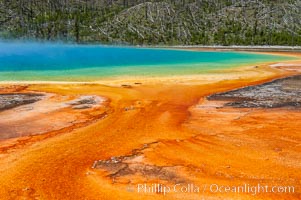
Grand Prismatic Spring displays brilliant colors along its edges, created by species of thermophilac (heat-loving) bacteria that thrive in narrow temperature ranges. The outer orange and red regions are the coolest water in the spring, where the overflow runs off.
Location: Midway Geyser Basin, Yellowstone National Park, Wyoming
Image ID: 07265
Location: Midway Geyser Basin, Yellowstone National Park, Wyoming
Image ID: 07265
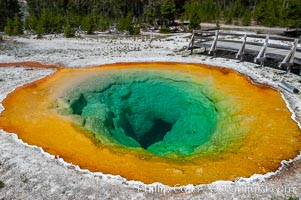
Morning Glory Pool has long been considered a must-see site in Yellowstone. At one time a road brought visitors to its brink. Over the years they threw coins, bottles and trash in the pool, reducing its flow and causing the red and orange bacteria to creep in from its edge, replacing the blue bacteria that thrive in the hotter water at the center of the pool. The pool is now accessed only by a foot path. Upper Geyser Basin.
Location: Upper Geyser Basin, Yellowstone National Park, Wyoming
Image ID: 07268
Location: Upper Geyser Basin, Yellowstone National Park, Wyoming
Image ID: 07268
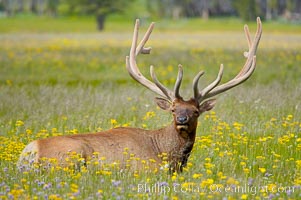
Elk graze and rest among wildflowers blooming in the Gibbon Meadow, summer.
Species: Elk, Cervus canadensis
Location: Gibbon Meadows, Yellowstone National Park, Wyoming
Image ID: 13159
Species: Elk, Cervus canadensis
Location: Gibbon Meadows, Yellowstone National Park, Wyoming
Image ID: 13159

Elk in the Gibbon River.
Species: Elk, Cervus canadensis
Location: Gibbon Meadows, Yellowstone National Park, Wyoming
Image ID: 13164
Species: Elk, Cervus canadensis
Location: Gibbon Meadows, Yellowstone National Park, Wyoming
Image ID: 13164
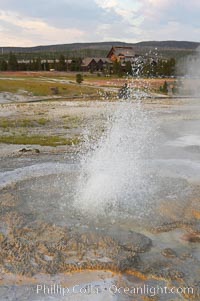
Anemone Geyser erupts, Old Faithful Inn visible in the distance. Anemone Geyser cycles about every 7 minutes. First the pools fills, then overflows, then bubbles and splashes before erupting. The eruption empties the pools and the cycle begins anew. Upper Geyser Basin.
Location: Upper Geyser Basin, Yellowstone National Park, Wyoming
Image ID: 13394
Location: Upper Geyser Basin, Yellowstone National Park, Wyoming
Image ID: 13394
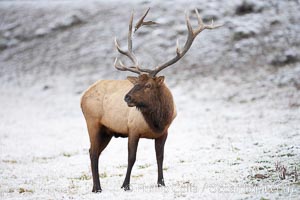
Large male elk (bull) in snow covered meadow near Madison River. Only male elk have antlers, which start growing in the spring and are shed each winter. The largest antlers may be 4 feet long and weigh up to 40 pounds. Antlers are made of bone which can grow up to one inch per day. While growing, the antlers are covered with and protected by a soft layer of highly vascularised skin known as velvet. The velvet is shed in the summer when the antlers have fully developed. Bull elk may have six or more tines on each antler, however the number of tines has little to do with the age or maturity of a particular animal.
Species: Elk, Cervus canadensis
Location: Yellowstone National Park, Wyoming
Image ID: 19692
Species: Elk, Cervus canadensis
Location: Yellowstone National Park, Wyoming
Image ID: 19692
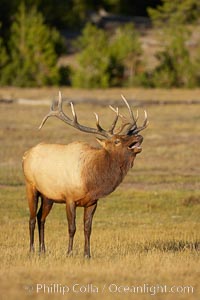
Male elk bugling during the fall rut. Large male elk are known as bulls. Male elk have large antlers which are shed each year. Male elk engage in competitive mating behaviors during the rut, including posturing, antler wrestling and bugling, a loud series of screams which is intended to establish dominance over other males and attract females.
Species: Elk, Cervus canadensis
Location: Yellowstone National Park, Wyoming
Image ID: 19695
Species: Elk, Cervus canadensis
Location: Yellowstone National Park, Wyoming
Image ID: 19695

Female elk along the Madison River during an early fall snow.
Species: Elk, Cervus canadensis
Location: Madison River, Yellowstone National Park, Wyoming
Image ID: 19701
Species: Elk, Cervus canadensis
Location: Madison River, Yellowstone National Park, Wyoming
Image ID: 19701

Male elk bugling during the fall rut. Large male elk are known as bulls. Male elk have large antlers which are shed each year. Male elk engage in competitive mating behaviors during the rut, including posturing, antler wrestling and bugling, a loud series of screams which is intended to establish dominance over other males and attract females.
Species: Elk, Cervus canadensis
Location: Yellowstone National Park, Wyoming
Image ID: 19703
Species: Elk, Cervus canadensis
Location: Yellowstone National Park, Wyoming
Image ID: 19703
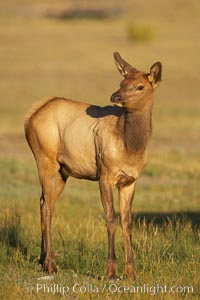
Juvenile elk in golden, late afternoon light, in meadow along Madison River, autumn.
Species: Elk, Cervus canadensis
Location: Yellowstone National Park, Wyoming
Image ID: 19704
Species: Elk, Cervus canadensis
Location: Yellowstone National Park, Wyoming
Image ID: 19704

Male elk bugling during the fall rut. Large male elk are known as bulls. Male elk have large antlers which are shed each year. Male elk engage in competitive mating behaviors during the rut, including posturing, antler wrestling and bugling, a loud series of screams which is intended to establish dominance over other males and attract females.
Species: Elk, Cervus canadensis
Location: Yellowstone National Park, Wyoming
Image ID: 19708
Species: Elk, Cervus canadensis
Location: Yellowstone National Park, Wyoming
Image ID: 19708

Male elk bugling during the fall rut. Large male elk are known as bulls. Male elk have large antlers which are shed each year. Male elk engage in competitive mating behaviors during the rut, including posturing, antler wrestling and bugling, a loud series of screams which is intended to establish dominance over other males and attract females.
Species: Elk, Cervus canadensis
Location: Yellowstone National Park, Wyoming
Image ID: 19714
Species: Elk, Cervus canadensis
Location: Yellowstone National Park, Wyoming
Image ID: 19714
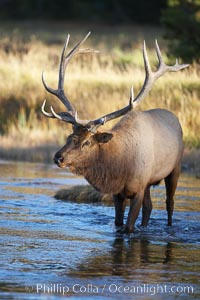
Male elk bugling during the fall rut. Large male elk are known as bulls. Male elk have large antlers which are shed each year. Male elk engage in competitive mating behaviors during the rut, including posturing, antler wrestling and bugling, a loud series of screams which is intended to establish dominance over other males and attract females.
Species: Elk, Cervus canadensis
Location: Madison River, Yellowstone National Park, Wyoming
Image ID: 19716
Species: Elk, Cervus canadensis
Location: Madison River, Yellowstone National Park, Wyoming
Image ID: 19716

Male elk bugling during the fall rut. Large male elk are known as bulls. Male elk have large antlers which are shed each year. Male elk engage in competitive mating behaviors during the rut, including posturing, antler wrestling and bugling, a loud series of screams which is intended to establish dominance over other males and attract females.
Species: Elk, Cervus canadensis
Location: Yellowstone National Park, Wyoming
Image ID: 19699
Species: Elk, Cervus canadensis
Location: Yellowstone National Park, Wyoming
Image ID: 19699
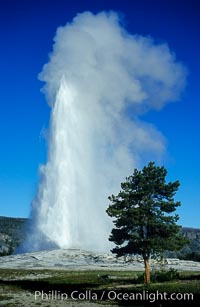
Old Faithful geyser, peak eruption.
Location: Upper Geyser Basin, Yellowstone National Park, Wyoming
Image ID: 07179
Location: Upper Geyser Basin, Yellowstone National Park, Wyoming
Image ID: 07179
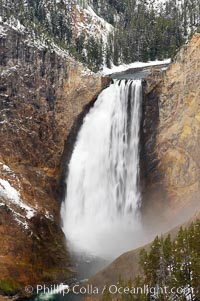
Snow covers the rocks and cliffs around Lower Yellowstone Falls in winter. At 308 feet, the Lower Falls of the Yellowstone River is the tallest fall in the park. This view is from Lookout Point on the North side of the Grand Canyon of the Yellowstone.
Location: Grand Canyon of the Yellowstone, Yellowstone National Park, Wyoming
Image ID: 19575
Location: Grand Canyon of the Yellowstone, Yellowstone National Park, Wyoming
Image ID: 19575
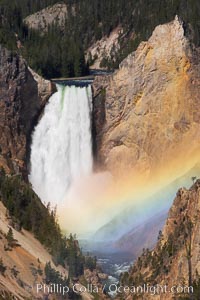
A rainbow appears in the mist of the Lower Falls of the Yellowstone River. At 308 feet, the Lower Falls of the Yellowstone River is the tallest fall in the park. This view is from the famous and popular Artist Point on the south side of the Grand Canyon of the Yellowstone. When conditions are perfect in midsummer, a morning rainbow briefly appears in the falls.
Location: Grand Canyon of the Yellowstone, Yellowstone National Park, Wyoming
Image ID: 13330
Location: Grand Canyon of the Yellowstone, Yellowstone National Park, Wyoming
Image ID: 13330

The Lower Falls of the Yellowstone River drops 308 feet at the head of the Grand Canyon of the Yellowstone. A long exposure blurs the fast-flowing water. The canyon is approximately 10,000 years old, 20 miles long, 1000 ft deep, and 2500 ft wide. Its yellow, orange and red-colored walls are due to oxidation of the various iron compounds in the soil, and to a lesser degree, sulfur content.
Location: Grand Canyon of the Yellowstone, Yellowstone National Park, Wyoming
Image ID: 13339
Location: Grand Canyon of the Yellowstone, Yellowstone National Park, Wyoming
Image ID: 13339
